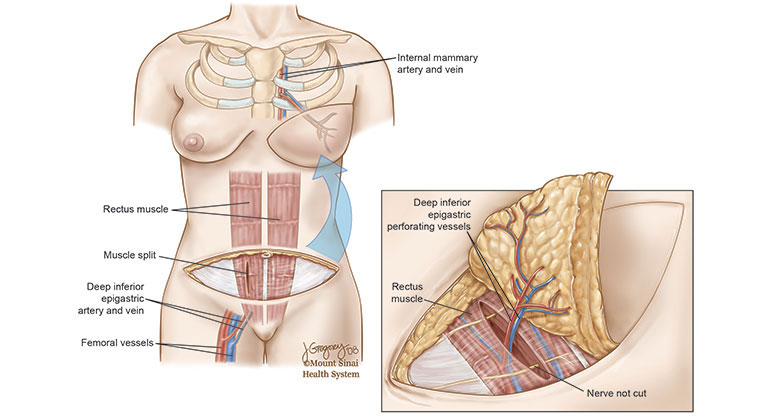Autologous (Microvascular) Breast Reconstruction
This approach takes a piece of skin and fat (called a “flap”) from one site on your body (such as the abdomen or thighs) and transfers it to your chest to reconstruct the breast after mastectomy. Autologous breast reconstruction offers several advantages compared to implant reconstruction:
- It is generally a single procedure that lasts a lifetime, since it consists completely of a patient’s own natural tissue (fat).
- Since it uses your own donor tissue instead of a foreign body, there is less chance of rejection or infection.
- This approach is more likely to look natural. While it is by no means guaranteed, you are more likely to regain sensation in your breast with autologous reconstruction than with an implant.
There are several ways to perform autologous breast reconstruction, with different techniques to transfer skin and fat from different areas of your body. At Mount Sinai West, under the direction of Hani Sbitany, MD, we have special expertise in the most advanced, muscle-sparing, microsurgical technique called DIEP (deep inferior epigastric perforator) flap breast reconstruction.
DIEP Flap Microvascular Breast Reconstruction

If you are a mastectomy patient considering breast reconstruction using your own tissue (autologous reconstruction), there are several options.
Traditional approaches to autologous breast reconstruction, such as the TRAM lap, transfer a small amount of muscle, along with its related skin and fat, in the reconstruction procedure. This approach sometimes requires a lengthy recovery and loss of movement and strength because of the muscle involvement. In general, the less muscle involved in the procedure, the better your function after recovery.
A newer, more advanced approach is deep inferior epigastric perforator artery (DIEP) flap microvascular reconstruction. This completely avoids any muscle transfer, and only involves the use of skin and fat. With this procedure, the surgeon removes a section of skin and fat from the lower abdominal roll and transfers it to the chest to rebuild your breast, while preserving all abdominal muscles. As an added benefit, because this procedure transfers a section of skin and fat from your lower abdomen, it tightens the remaining abdominal skin, resulting in what is often referred to as a “tummy tuck.”
The DIEP flap procedure is not right for every patient. You must first want to use autologous (tissue) reconstruction after a mastectomy. You must also have sufficient fat tissue in the lower abdomen to meet your goals for breast size and shape. In addition, the procedure is not appropriate for women who have previously had certain types of abdominal surgery.
The highly advanced DIEP flap technique offers many benefits, and requires the highly specialized skills of a microsurgeon.